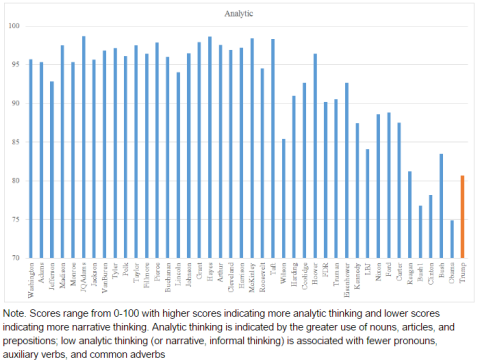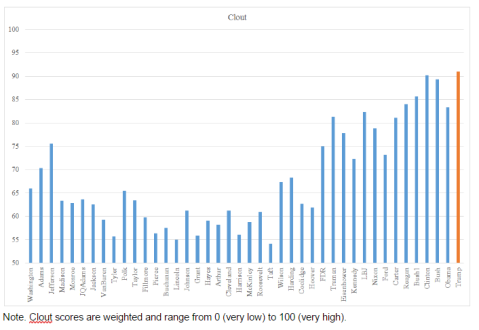Trump’s First State of the Union Address
March 1, 2017
Kayla N. Jordan and James W. Pennebaker
University of Texas at Austin
After just over a month in office, Donald Trump gave his first address to Congress. The content of Trump’s address was similar to past presidents’ State of the Union (SOTU) addresses with a focus on recent accomplishments and plans for the upcoming year. But what about the style of the speech?
Unlike his inaugural address which was linguistically similar to Trump’s typical language, his recent address was more analytic and less authentic than normal. Similar to his RNC acceptance speech, Trump’s first SOTU was heavily shaped by a speechwriter. Although the content of the address overlapped considerably with Steve Bannon’s recurring themes of fear of outsiders, the linguistic markers were quite similar to the language of Stephen Miller in a recent interview on Face the Nation. Despite Miller’s probable role in the address, Trump’s latest speech is useful in understanding overall trends in the presidency and where Trump fits in.
Decline in Analytic Thinking
Similar to trends in inaugural addresses, SOTU speeches are generally highly analytic and formal, but have been becoming less so over time. Starting with Woodrow Wilson and Franklin Roosevelt, modern presidents have adopted a more informal, narrative style in their annual addresses to Congress. Trump’s first address continued this trend with his level of analytic thinking on par with the last 5 presidents.
The decline in analytic thinking signals a shift in how presidents are thinking about problems and presenting their ideas. Trump, like other recent presidents, laid out his ideas in a simpler, more straightforward way than past presidents. Going forward, Trump will likely rely more and more on offering simple, intuitive solutions and ideas to the problems he faces.

Rise in Confidence
The language presidents use can show how confident and self-certain they are as leaders. Confidence or clout is indicated by more we-words and social words and fewer I-words, negations (e.g. no, not), and swear words.
Whereas analytic thinking has decreased over the last century, clout has increased. Around the same time presidents began becoming less analytic, they also started to exude more confidence. Presidents have increasingly approached these addresses to Congress with confidence and certainty. Trump is the most confident so far, but is still similar to recent presidents. Trump and other modern presidents are decisive and confident in their plans and proposals.

The Big Picture
In their SOTU addresses, presidents have been becoming more confident and less analytic. These trends show that presidents are changing how they are thinking and interacting with lawmakers and the American people. Administration after administration, the yearly SOTU addresses are laying out simpler and less nuanced world views with bolder more decisive proposals. Faced with complex, hard-to-solve problems, clear and easy solutions are likely more appealing to present to an increasingly polarized Congress (and electorate).
While Trump is often seen as a significant departure from presidential norms, in many ways, he isn’t all that different than other modern presidents. Rather than being an extreme outlier, Trump is part of long-term trends. He is a more confident, intuitive thinker, but Obama and Bush were as well. The content of what Trump is saying may be abnormal, but the style is typical of recent presidents.